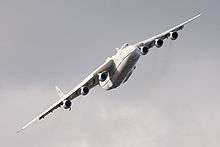Cargo airline
Cargo airlines (or airfreight carriers, and derivatives of these names) are airlines mainly dedicated to the transport of cargo by air. Some cargo airlines are divisions or subsidiaries of larger passenger airlines.
Logistics
Air transport is a component of many international logistics networks, managing and controlling the flow of goods, energy, information and other resources like products, services, and people, from the source of production to the marketplace. Logistics involves the geographical repositioning of raw materials, work in process, and finished inventories.[1]
Aircraft used
Larger cargo airlines tend to use new or recently built aircraft to carry their freight, but many use older aircraft, like the Boeing 707, Boeing 727, Douglas DC-8, DC-10, MD-11, Boeing 747, Airbus A300, and the Ilyushin Il-76. Examples of the 60-year-old Douglas DC-3 are still flying around the world carrying cargo (as well as passengers). Short range turboprop airliners such as the An-12, An-26, Fokker Friendship, and British Aerospace ATP are being modified to accept standard air freight pallets to extend their working lives. This normally involves the replacement of glazed windows with opaque panels, the strengthening of the cabin floor and insertion of a broad top-hinged door in one side of the fuselage.

Antonov An-225 Mriya and Antonov An-124 are the world's largest aircraft, used for transporting large shipments and oversized cargos.[2][3]
Usage of large military airplanes for commercial purposes, pioneered by Ukraine's Antonov Airlines in the 1990s, has allowed new types of cargo in aerial transportation.
In the past, some cargo airlines would carry a few passengers from time to time on flights, and UPS Airlines once unsuccessfully tried a passenger charter airline division. However, cargo planes in the United States are forbidden from carrying non-employee passengers.[4]
Top 10 cargo airlines
By freight tonne-kilometres flown (millions):[5]
| Rank | Airline | 2015 |
|---|---|---|
| 1 | | 16,020 |
| 2 | | 11,240 |
| 3 | | 10,936 |
| 4 | | 9,464 |
| 5 | | 8,079 |
| 6 | | 7,054 |
| 7 | | 6,019 |
| 8 | | 5,997 |
| 9 | | 5,753 |
| 10 | | 5,266 |
All-cargo


Some of the largest all-cargo carriers are:[6]
- ABX Air
- AeroLogic
- AirBridge Cargo
- BAX Global
- Cargolux
- DHL
- FedEx Express
- Kalitta Air
- Martinair
- Nippon Cargo Airlines
- Polar Air Cargo
- TNT Airways
- UPS Airlines
All-cargo subsidiary

_arrives_London_Heathrow_11Apr2015_arp.jpg)

Freight divisions of passenger airlines operating their own or leased freighter aircraft, some have shut down or merged with others.[6]
- Aeroflot-Cargo
- Air Canada Cargo
- Air China Cargo
- Air France Cargo
- Air Hong Kong (Cathay Pacific)
- Air India Cargo
- Air Macau Cargo
- ANA Cargo
- Asiana Cargo
- Avianca Cargo
- Cathay Pacific Cargo
- China Airlines Cargo
- China Cargo Airlines (China Eastern Airlines)
- China Southern Cargo
- Delta Air Freight
- EgyptAir Cargo
- EL AL Cargo
- Emirates SkyCargo
- Ethiopian Airlines Cargo
- Etihad Crystal Cargo
- EVA Air Cargo
- Finnair Cargo
- Hong Kong Airlines Cargo
- IAG Cargo
- Icelandair Cargo
- Iran Air Cargo
- Korean Air Cargo
- LAN Cargo
- Lufthansa Cargo
- MASkargo
- Qatar Airways Cargo
- RAM Cargo
- Royal Jordanian Cargo
- Saudi Arabian Airlines Cargo
- Shanghai Airlines Cargo
- Singapore Airlines Cargo
- South African Airways Cargo
- TAM Cargo
- Turkish Airlines Cargo
- Uzbekistan Airways Cargo
- Yakutia Airlines Cargo
Freight divisions without fleet using passenger aircraft belly hold or having other cargo airlines fly on their behalf, some of these previously had freighters:
- Alaska Air Cargo (2 cargo planes, 13 on order)
- American Airlines Freight
- British Airways World Cargo (opb Global Supply, three a/c to be in full BA Cargo scheme)
- Caribbean Airlines
- Cargo Garuda Indonesia
- Czech Airlines Cargo
- Delta Airlines Cargo
- Dragon Air Cargo
- Gol Transportes Aéreos
- Gulf Air Cargo
- Hainan Airlines Cargo
- Iberia Cargo
- Japan Airlines Cargo
- Jet Airways Cargo
- Kenya Airways Cargo
- KLM Cargo (opb Martinair Cargo, four a/c in full KLM scheme)
- Kuwait Airways Cargo
- LOT Polish Airlines Cargo
- Pakistan International Airlines Cargo
- Philippine Airlines Cargo
- Qantas Freight (two a/c opb Express Freighters in Qantas scheme minus logo)
- SAS Cargo Group
- Shaheen Air Cargo
- Shenzhen Airlines Cargo
- Sichuan Airlines Cargo
- South African Airways
- SriLankan Cargo
- Sudan Airways
- Swiss WorldCargo
- Thai Airways Cargo (two aircraft operated by Southern Air in full Thai Cargo scheme)
- United Airlines Cargo
- Virgin Atlantic Cargo
These carriers operate freighter aircraft but do not have a cargo division:
- Air Koryo
- Ariana Afghan Airlines
- Azerbaijan Airlines
- Iraqi Airways
- Syrian Air
- Tajik Air
- Turkmenistan Airlines
See also
- Airlift
- Cargo aircraft
- Container terminal
- Counter-to-counter package
- Dangerous goods
- Environmental impact of aviation
References
- ↑ Bartsch, Butsri (24 May 2013). "Air freight - it could not be faster!". BB Handel. Retrieved 29 May 2013.
- ↑ "Chapman Freeborn charters first AN-225 to South America". Chapman Freeborn Airchartering.
- ↑ "Argentina's First Satellite Delivered on AN-124 Cargo Charter". Chapman Freeborn Airchartering.
- ↑ "Passengers And Crew On Cargo Aircraft" (PDF). Federal Aviation Administration. 21 January 2004. Retrieved 29 May 2013.
- ↑ "Archived copy". Archived from the original on 2012-12-15. Retrieved 2012-12-15.
- 1 2 "World's 50 largest air cargo carriers in 2014: FedEx leading the way". Air Cargo News. 15 September 2015. Retrieved 25 March 2016.
External links
| Wikimedia Commons has media related to Cargo airlines. |

